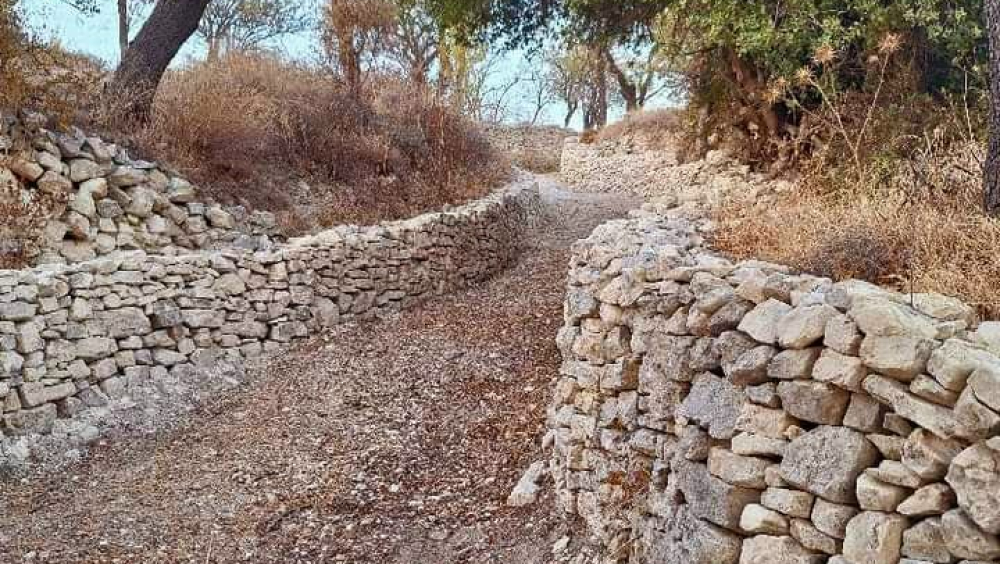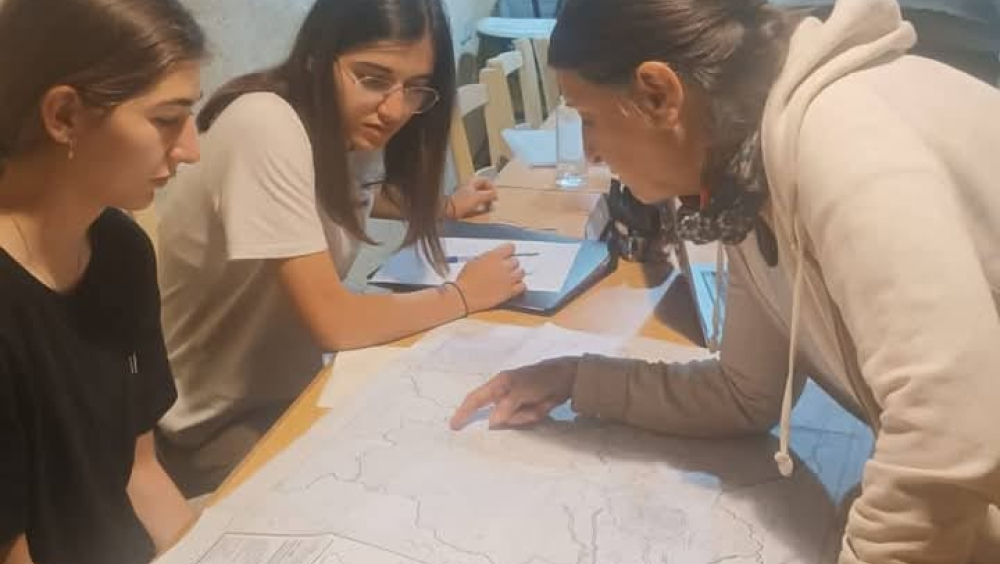Stories about people behind the drystone walls, their grains, and vines
Salamiou has many intertwining stories that together define its landscape, suggesting a society with a deep-rooted understanding of their environment. While such stories are intimately connected to particular places and people, once stories are assembled and brought out of oblivion, they represent a wider shared heritageof common human and more-than-human values, that spread across continents.
Surrounding Salamiou within a radius of about 5 Km, each story converges upon unique drystone constructions spanning a continuous farming history of over 2000 years. Each story is entangled with the earthy terraced farming heritage, supported by drystone walling, a building method by which stones are assembled without any mortar to stabilise mountain slopes, forming strips of fields which in turn restore soil. Drystone structures separate properties, but also provide shelters for farmers and their animals. The same technique shapes wells, lime-pits, ancient tombs; the list goes on as we, passionate individuals and associations, aim to give a voice to local communities who wish to share their stories, resiliently passed down generations, recounted with love and care. More than merely re-telling stories which we uncover and which local people are increasingly energised to recall, we realise that stories extend beyond human effort that has reconfigured the landscape to create and sustain a more-than-human environment.
By recounting stories, we connect to generations that preceded us. We measure their involvement and commitment, but we are also faced with our own transience, allowing for other meanings to emerge, that evoke a disparate system of valuation. We see the stones shaping landscape tracings as active ways of holding knowledge, as a register of past actions, an archive of centuries of communal effort, an instrument of measure of spatial possibilities, which also bear poetic value; where the geological, the natural world and human imagination converge (MacFarlane 2003).
1: “…The sun sets over the slopes of powerful Xeros river, where hundreds of ancient olive trees cast their long shadows on the ground. It is necessary that people care for them, we are told by locals but they also require authorities’ protection. Locals take from their own free time to clear undergrowth, to remove dying branches, to cut back choking weeds surrounding the trees . They carefully cultivate the soil, breaking it up by hand to air the roots, allowing for rain to deeply percolate. Upon the slope, water is contained by low, ancient drystone semi-circles edged against the incline, surrounding each tree. In times past, people would lop off branches for firewood creating gashes into the tree trunks. Farmers counteracted these cuts by stacking and splicing dry stones carefully into these cleaves, so that over years, the bark of the tree and the stones have merged in healing acceptance of each other. Locals believe that the Apostolic trees, grew when the Apostles Paul, Barnabas, and Marco in 45 CE stopped to rest, taking bread and olives, on their way to ancient Paphos. Such stories inform an invaluable part of Salamiou’s Christian oral intangible heritage, which was well-respected during past centuries by the areas Muslim Turkish speaking Cypriots. Each ancient majestic tree bears its own, distinct, sentient personality. These trees stand as nature’s timeless works of art. To arrive at this ancient grove, one must follow a trail on foot, composed of mixed tracings, which span at least two thousand years; traversing shepherd’s paths through the drystone landscape, but also trails left by wild Moufflon herds, as well as stretches that witness remnants of roads from Roman to Colonial times…”
2: The following Salamiou story about Foinike and Papa Yiorkos, comes from their sons, Panayiotis and Argyris Panayiotou.
“…During the second world war, a young man and his fiancé took matters into their own hands in order to avert imminent hunger. They removed wild growth by hand, from their abandoned drystone terraces, around Aetomoutti hill. They tilled the soil, digging it themselves). They then planted the terraces belonging to their grandparents; they sowed wheat for themselves and their family, and barley for their animals. Two young people working together, were thus able to provide grain for both their families and all of their animals for a whole year. They kept this up thorough the war years, knowing when to sow wheat on the lower terraces beside the seasonal Xeros river, which retained moisture (when there was drought), or on higher terraces when a good winter of rains kept soil moist higher up the slope. They would have relied upon advice of their older family members, to help them succeed.
This relative success of self-sufficient, communally grown grain and other staples by and for a small community, reveal possibilities that have gone by largely undocumented and hugely overlooked by the Capitalocene. This knowledge needs to be empirically re-learnt, since there are no historical records or maps of terraces, save their mention as a potential for cultivation, in an overlooked Department of Agriculture report submitted to the Colonial administration by a young Greek agronomist (Gennadios, 1896).
3: A tall walled drystone enclosure acted as a nursery for young grape seedlings described in 1340 by Ludolf, a German travelling priest from Westfalia who had travelled to Cyprus between 1336 and 1341 (Hadjisavvas, 2020). Ludolf describes the vineyard thus:
“…In the same province of Paphos is the vineyard of Engadi: its like is nowhere found. It is situated in a very high mountain, and measures two miles in length and in breadth, girt on all sides with lofty rock and a wall; on one side it has a very narrow entrance and within it is quite level. In this vineyard grow vines and clusters of many different kinds, some of which produce grapes of the bigness of plums, others, small grapes like peas, others again, grapes without stones, or grapes in shape like an acorn, all transparent, and grapes and clusters of many other kinds are seen therein. It belonged to the Templars, and more than a hundred Saracen captives were daily therein, whose only task was to clean and watch the vineyard, and indeed I have heard from many of experience that God has made for the use of men no fairer or nobler ornament under the sun…”.[1]
There is a surviving similar unique triangular drystone enclosure that surrounds an elongated ridge at Lakria locality, overlooking the Diarizos river, and about 2.5 km to east of Salamiou. It may be a part of what Ludolf witnessed, measuring roughly 300 x 300 m and about 150m, at its westernmost side, with walls which are 1.5 m tall and 1.5m broad, extending to 2m in width on the northern side. On the south there is a single opening of finely dressed corners measuring about 2m in width, just as Ludolf describes. The walls are built with densely packed irregular limestone woven together in tightly knit drystone. The tall surrounding drystone wall would have been created by a community of expert hands, to provide a sheltered microclimate that protected young plants from wind and frost. Locals call this “The Chinese wall of Salamiou’ and it was here that the whole village took cover behind this wall, beating back a raging fire in 1996, rushing up the slope towards them.
The Saracen slaves whom Ludolf saw tending this garden, may possibly have been from the lost crusader kingdom in historic Palestine, who would have brought with them centuries of knowledge of their own terraced vineyards. Knowledge and expertise were also transplanted together with the new grape varieties. In 1340, Ludolf would have witnessed this garden in its maturity. His account is valuable because it not only documents the enclosing drystone structure, listing rare grape varieties, but he also mentions those tending the garden enclosure, hinting at their numbers and aware of the transferred knowledge, but also culture, brought over from their own lands.
In a European dimension, today the terraced landscapes can be perceived as artscapes, language-scapes, soundscapes, and even memoryscapes, creating through their repository catalogue of knowledge, benefits for future sustainability.
I observe how children of local Salamiotes never tire of hearing stories recounted over and over by their elders as they grow up. Over the years, and as their lives change into an urban, mechanised habitat, local community members, old and young, realise that they are the last witnesses of a way of life that is no more, but that is still alive through their knowledge entangled within memory. By sharing their stories, a wider picture of shared landscape heritage emerges. Apart from the Christian heritage of the area, we are also finding intertwined memories of neighbouring formerly Muslim communities such as Stavrokonnou and Ayios Ioannis. Together, these materially intertwined practices of once-upon-a-time terraced farming re-tell ways of mutual respect and cohabitation, of people of different creeds that equally cared for their lands and landscape. A way of sustaining both stories and landscape is emerging through the field of heritage, by celebrating these hinterland mountain societies that have dedicated themselves to practicing the rhythms of soil, landscape, cultivation and drystone building, mixed with the vibrancy of life.
Still more stories make us aware of the wider island’s history which has always been determined its geography as a crossroad aiding movement of peoples between east and west. Often, both people, but also knowledge of new cultivations is seen transplanted from other shores. Moreover, particularly in our times, such knowledge is seen to root itself through inclusivity and communal care, becoming a unique intimate place, an ‘oikeios topos’. Transformed into tradition, such practices in turn, may carry common values to distant shores; or even if we let them, across the island’s political divide.

